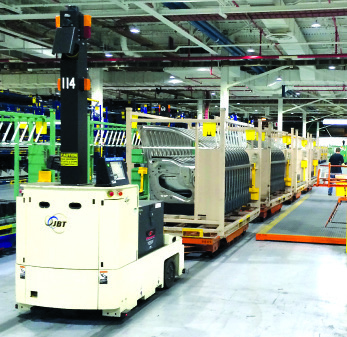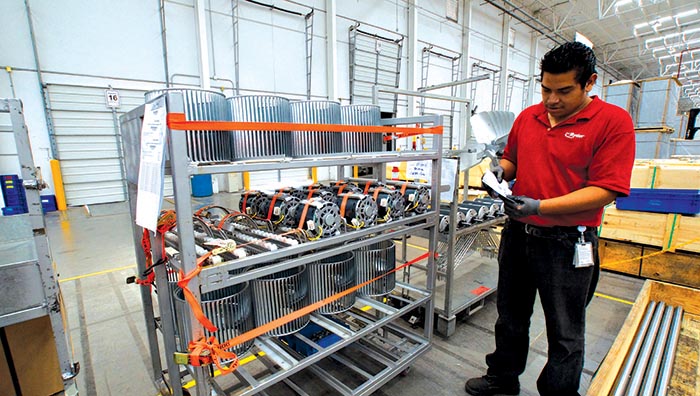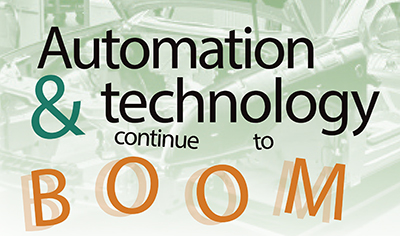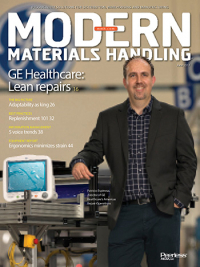Automotive: Automation and technology continue to boom
With yet another record automotive sales year expected in 2017, the popularity of materials handling automation and technology is increasing at a steady pace.
Whether it’s due to a decline in average gasoline prices across the country, easier credit or a rise in national employment, new car sales have risen consistently in recent years. According to The New York Times, an all-time record 17.47 million new cars were sold in 2015—5.7% more than in 2014, and roughly 70,000 more than in 2000, when the previous record was established.
The upsurge continued last year with 17.55 million new vehicles being purchased, setting yet another record. And now automotive industry and financial experts are anticipating another potential record-setting year in 2017, with organizations like Morgan Stanley predicting a 2% to 4% rise in new car sales.
With no signs of diminished demand in sight, at least for the remainder of the year, automotive manufacturers have responded by investing in new materials handling automation equipment and technologies that improve the effectiveness, safety and timeliness of various aspects of their plants, continue to meet customer demands, and increase bottom lines. Here is a summary of a few equipment options, technologies and automation processes currently influencing North American automakers and suppliers.
AGV and AGC popularity continues to rise
 As confidence in automation continues to increase, automatic guided vehicles (AGVs) are becoming even more popular within the industry. Not only are professionals more comfortable with robots and self-driving cars, they are also interested in automating their entire enterprise of manufacturing plants, rather than just one area of one plant, thereby improving the overall perception of AGVs.
As confidence in automation continues to increase, automatic guided vehicles (AGVs) are becoming even more popular within the industry. Not only are professionals more comfortable with robots and self-driving cars, they are also interested in automating their entire enterprise of manufacturing plants, rather than just one area of one plant, thereby improving the overall perception of AGVs.
Consequently, according to Mark Longacre, marketing manager at JBT Corp., AGV applications—such as the delivery of raw materials and the removal of finished goods—are now increasing in all areas of the automotive industry, including assembly, and power and transmission. In response to this rise in applications, a variety of new technologies have recently been developed to improve the capability of some AGVs, including revised camera-based and laser-based sensors and natural environment navigation.
“With this type of navigation, sensors enable AGVs to use facility infrastructure as landmarks to accurately move around as they detect walls, racking and other fixed plant equipment without the need for magnetic tape or reflective strips,” Longacre says. “In addition, camera-based and laser-based sensors have improved dramatically, making it easier for AGVs to detect pallets, interface with facility equipment and perform a greater number of tasks.”

Aside from this technology, AGVs also offer automotive plants a steady, predictable movement that reduces product and warehouse damage, increases operator safety and decreases labor costs. This steadiness is ideal within the industry, as 24/7 operating cycles, predictable part movements and flexibility are necessities for automotive facilities.
“Although the future of AGVs is very bright, the industry is not fully saturated with them just yet. However, we’re quickly approaching a tipping point since vehicle capability is rising while costs are dropping,” Longacre explains. “Soon, people in the automotive industry will become even more familiar with AGVs and will see them everywhere.”
Another choice for automation is automatic guided carts (AGCs), particularly as a means to minimize the usage of forklifts, reduce errors and improve on-the-job safety. According to Chris Youngs, account executive at DMW&H, AGCs and AGVs can each be used to achieve these workplace goals, as they perform similar functions in different ways.
“Deciding whether an AGV or AGC is a better fit for an application is usually a matter of complexity,” says Youngs. “It’s best to utilize an AGV if you have very complex routing with multiple pickup/drop-off locations where path decisions are based on real-time variables. An AGC, on the other hand, is a better choice if it’s a relatively fixed route (an oval or bi-directional path) where few variables and limited decision making is required.”
The promising future of autonomous vehicles and robotics
Forklift manufacturers are improving their diagnostic capabilities so that managers can better monitor the performance of their machines. Such capabilities, along with real-time data analytics tools, allow operators to identify potential issues, advocate solutions and even predict future events, according to Gary Allen, vice president of supply chain excellence at Ryder.
“Through real-time analytics, operators can receive their data instantaneously and utilize their equipment more efficiently,” Allen says. “In fact, as materials handling equipment—along with the products and tools that manage the equipment—becomes digital, maintenance activity, as a whole, will be better performed.”
Aside from technology like diagnostics and real-time data analytics, autonomous materials handling equipment is also advancing. And, unlike other vehicles that can only function through markers and infrastructure improvements, these vehicles can learn travel paths.
“With the release of such technology, the future of autonomous vehicles is promising, especially in the 3PL space, in that, when they mature, they will offer solutions that are both scalable and transferable,” says Allen.
The usage of robots continues to increase as well, as Tier 1 and Tier 2 automotive suppliers are implementing them to automate various processes. After all, not only are Tier 1 and Tier 2 suppliers trying to reduce their per unit costs, but automobile assembly plants prefer to have Tier 1 and Tier 2 suppliers’ systems as automated as possible, leading to two potential outcomes—greater supply chain visibility and, ultimately, a reduction in just-in-time deliverables’ lead times.
“Auto assembly plants have been using robots to automate various processes for years. Over time, their downstream suppliers have seen the benefits of that automation,” says DMW&H’s Youngs. “Since robots have become more mainstream in the automotive landscape, it’s become easier to justify automation and expand their roles into new areas.”
In particular, automotive companies are beginning to rely more on standard industrial robots as they transfer vehicle bodies from one conveyance system to another, rather than using custom pieces of automation to handle vehicle bodies. This use of robots has become apparent in a variety of automotive operations, too, from kitting to the assembly line. Even some body fork transfer devices are now being replaced with robots, while continuing to perform the exact same functions as before, according to Noel Dehne, vice president of automotive factory automation for Daifuku America Corp.
Due to the recent shift in using robotics within an array of processes, end-of-arm tooling (EOAT) has been developed, so that robots can perform more complex tasks. Additionally, as the popularity of robotics continues to rise, automotive facilities must be able to “feed” robotic cells as efficiently, quickly and safely as possible.
“This is accomplished by using various technologies—mini-load cranes, shuttle systems, pallet moles, AGVs, AGCs, chain conveyors and monorail-style offerings—that are automated to feed the robotic cells and take their output to its next destination,” Youngs explains. “Given the tougher mandates original equipment manufacturers are placing on their Tier 1 and Tier 2 suppliers, it’s becoming too expensive, in terms of accuracy, efficiency and time, not to automate a majority of these processes.”
Integrative systems approaches complement OEMs
With the market booming, many automotive companies are starting to invest more capital in their manufacturing plants’ infrastructure—whether they are improving their current plant production systems to handle a higher throughput; adding more space to ensure their manufacturing capabilities remain flexible; or attempting to maximize the use of their plant floor space.
“The volume of work has actually maxed out the capacity of conveyor manufacturers and system controls vendors in North America,” says Daifuku’s Dehne.
As new plant production systems are developed, or old ones are upgraded and enlarged, some automakers’ suppliers are providing integrated systems approaches in general assemblies. These approaches—in which automakers install complete and functional operations that incorporate suppliers’ equipment, above and beyond their own fabricated components—complement the OEMs who have had to reduce the amount of time they have to either plan or implement additions or changes within their manufacturing systems, due to other responsibilities, as well as financial issues.
“In lieu of building new plants, many OEMs are doing their best to squeeze more production, such as 10 jobs per hour, out of existing facilities,” Dehne adds. “So, more and more OEMs are now relying on suppliers that completely understand their requirements and can provide turnkey solutions.”
She adds, “Some automakers may, for instance, fabricate conveyors, but the complete job also requires robots and automation. All of these pieces must work together like the keys of a finely tuned piano, which is why a turnkey integrated solution is so valuable.”
Companies mentioned in this article:
Daifuku America Corporation
DMW&H
JBT Corporation
Ryder

Article Topics
Special Reports News & Resources
Automation/Retail Special Issue: Savvy users embrace change Research Report: Use of Automation in Warehouse/DC Special Digital Issue: Warehouse/DC Robotics System Report: Building the world’s best warehouse Top 20 Warehouses 2019 Top 20 automatic identification and data capture suppliers 2019 Top 20 Lift Truck Suppliers in 2019: Market reaches new heights More Special ReportsLatest in Materials Handling
Hyster recognizes Dealers of Distinction for 2023 Carolina Handling names Joe Perkins as COO C-suite Interview with Keith Moore, CEO, AutoScheduler.AI: MODEX was a meeting place for innovation Walmart deploying autonomous lift trucks at four of its high-tech DCs Coles shops big for automation Kathleen Phelps to join FORTNA as chief financial officer Coles automates grocery distribution in Australia More Materials HandlingAbout the Author
Subscribe to Materials Handling Magazine

Find out what the world's most innovative companies are doing to improve productivity in their plants and distribution centers.
Start your FREE subscription today.
April 2024 Modern Materials Handling

Latest Resources












